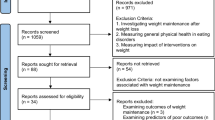Abstract
Objective
To identify risk-groups adhering to weight-changing plans for body dissatisfaction in a National sample of Iranian students.
Design
Cross-sectional.
Setting
Primary, Middle and high-schools.
Participants
13486 students (mean age, 12.5 y).
Main outcome measures
Demographic and anthropometric characteristics were collected via valid instruments. Body image and adherence to weight- changing diets were assessed by using validated questionnaires.
Results
46.5% students were satisfied with their weight and12.5% declared that they had attempts for weight control, this was significantly higher among adolescent girls (13.8%, P=0.0005). Participants who perceived themselves as overweight and obese, were more likely (OR= 5.32) to follow weight-reduction diets than their peers with normal-weight perception. Actual overweight-BMI and obese-BMI individuals had greater odds for being on a diet (1.3 and 1.47, respectively) compared to their normal-BMI counterparts.
Conclusion
Promoting strategies to improve body image concerns and prevent adverse outcomes of chronic dieting among adolescents are necessary.
Similar content being viewed by others

References
Wood-Barcalow NL, Tylka TL, Augustus-Horvath CL. “But I Like My Body”: Positive body image characteristics and a holistic model for young-adult women. Body Image. 2010;7:106–16.
Smolak L. Body image in children and adolescents: where do we go from here? Body Image. 2004;1:15–28.
Schneider S, Weiss M, Thiel A, Werner A, Mayer J, Hoffmann H, et al. Body dissatisfaction in female adolescents: extent and correlates. Eur J Pediatr. 2013;172:e373–84.
Eisenberg ME, Neumark-Sztainer D, Paxton SJ. Five-year change in body satisfaction among adolescents. J Psychosom Res. 2006;61:521–7.
Andrist LC. Media images, body dissatisfaction, and disordered eating in adolescent women. MCN Am J Matern Child Nurs. 2003;28:119–23.
Field AE, Javaras KM, Aneja P, Kitos N, Camargo CA, Jr., Taylor CB, et al. Family, peer, and media predictors of becoming eating disordered. Arch Pediatr Adolesc Med. 2008;162:574–9.
Kanter R, Caballero B. Global gender disparities in obesity: a review. Adv Nutr. 2012;3:491–8.
Schulte SJ, Thomas J. Relationship between eating pathology, body dissatisfaction and depressive symptoms among male and female adolescents in the United Arab Emirates. Eat Behav. 2013;14:157–60.
Kelishadi R, Marashinia F, Heshmat R, Motlagh ME, Qorbani M, Taslimi M, et al. First report on body image and weight control in a nationally representative sample of a pediatric population in the Middle East and North Africa: the CASPIAN-III study. Arch Med Sci. 2013;9:210–7.
Khashayar P, Heshmat R, Qorbani M, Motlagh ME, Aminaee T, Ardalan G, et al. Metabolic syndrome and cardiovascular risk factors in a national sample of adolescent population in the Middle East and North Africa: The CASPIAN III Study. Int J Endocrinol. 2013; 2013:702095.
Kelishadi R, Majdzadeh R, Motlagh ME, Heshmat R, Aminaee T, Ardalan G, et al. Development and evaluation of a questionnaire for assessment of determinants of weight disorders among children and adolescents: The Caspian-IV Study. Int J Prev Med. 2012;3:699–705.
Kelishadi R, Ardalan G, Qorbani M, Ataie-Jafari A, Bahreynian M, Taslimi M, et al. Methodology and early findings of the fourth survey of Childhood and Adolescence Surveillance and Prevention of Adult Noncommunicable Disease in Iran: The CASPIAN IV study. Int J Prev Med. 2013;4:1451–60.
Knowles KM, Paiva LL, Sanchez SE, Revilla L, Lopez T, Yasuda MB, et al. Waist circumference, body mass index, and other measures of adiposity in predicting cardiovascular disease risk factors among Peruvian adults. Int J Hypertension. 2011;2011:931402.
Li C, Ford ES, Mokdad AH, Cook S. Recent trends in waist circumference and waist-height ratio among US children and adolescents. Pediatrics. 2006;118:e1390–e8.
Petracci E, Cavrini G. The effect of weight status, lifestyle, and body image perception on health-related quality of life in children: a quantile approach. Qual Life Res. 2013;22:2607–15.
Mohnke S, Warschburger P. [Body dissatisfaction among female and male adolescents: comparing prevalence, predictors, and consequences between the sexes]. Prax Kinderpsychol Kinderpsychiatr. 2011;60:285–303.
Pon LW, Mirnalini K, Mohd Nasir M. Body image perception, dietary practices and physical activity of overweight and normal weight Malaysian female adolescents. Malays J Nutr. 2004;10:131–47.
Herzog DB, Keller MB, Lavori PW, Kenny GM, Sacks NR. The prevalence of personality disorders in 210 women with eating disorders. J Clin Psychiatry. 1992;53:147–52.
Cho JH, Han SN, Kim JH, Lee HM. Body image distortion in fifth and sixth grade students may lead to stress, depression, and undesirable dieting behavior. Nutr Res Pract. 2012;6:175–81.
Calzo JP, Sonneville KR, Haines J, Blood EA, Field AE, Austin SB. The development of associations among body mass index, body dissatisfaction, and weight and shape concern in adolescent boys and girls. J Adolesc Health. 2012;51:517–23.
Neumark-Sztainer D, Paxton SJ, Hannan PJ, Haines J, Story M. Does body satisfaction matter? Five-year longitudinal associations between body satisfaction and health behaviors in adolescent females and males. J Adolesc Health. 2006;39:244–51.
Yeh MC, Liou YM, Chien LY. Development and effectiveness of a school programme on improving body image among elementary school students in Taiwan. J AdvNurs. 2012;68:434–43.
Author information
Authors and Affiliations
Corresponding author
Rights and permissions
About this article
Cite this article
Bahreynian, M., Qorbani, M., Motlagh, M.E. et al. Association of perceived weight status versus body mass index on adherence to weight-modifying plan among Iranian children and adolescents: The CASPIAN-IV study. Indian Pediatr 52, 857–863 (2015). https://doi.org/10.1007/s13312-015-0732-9
Received:
Revised:
Accepted:
Published:
Issue Date:
DOI: https://doi.org/10.1007/s13312-015-0732-9



